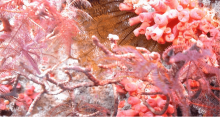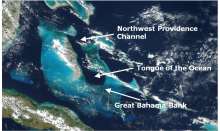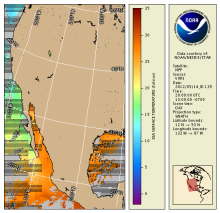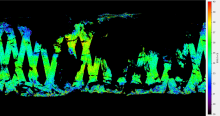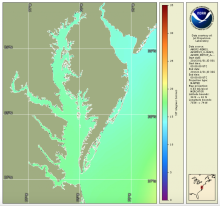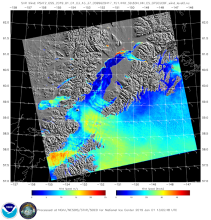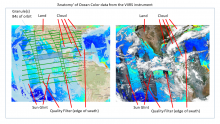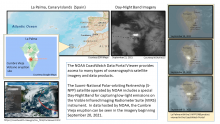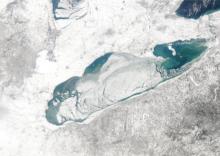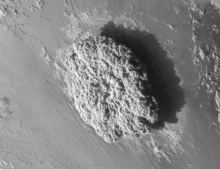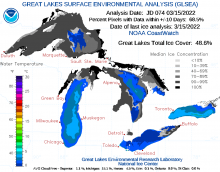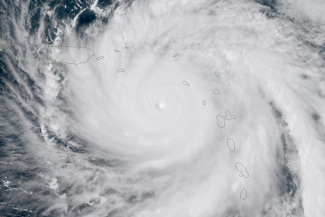
Climate & Weather
Ocean acidification in the Caribbean
User Story
In collaboration with the NOAA Atlantic Oceanographic and Meteorological Laboratory's Ocean Chemistry and Ecosystems Division and NOAA Coral Reef Watch, the Caribbean/Gulf of America node of CoastWatch produces an ocean acidification product suite for the greater Caribbean region to track changes in the surface ocean that can be used as an important tool in coral reef research and management.
A Satellite's View of Coastal Erosion
User Story
One expected impact of climate change is an increase in the frequency and severity of storms in the eastern United States. As such, many coastal communities and ecosystems are increasingly vulnerable to the detrimental impacts of coastal erosion. The CoastWatch East Coast node monitors coastal erosion by tracking in-water sediment values.
Detecting Sea Level Anomalies with Satellites
User Story
By studying sea level anomalies, scientists can improve understanding of ocean circulation patterns and improve forecasts of climatological events such as El Niño and La Niña. The NOAA Laboratory for Satellite Altimetry produces daily near-real time global sea level anomaly datasets from a constellation of radar altimeter missions.
Improving Satellite Sea Surface Temperature Analysis
User Story
Information about sea surface temperature is important for weather and ocean forecasting, climate monitoring, military and defense operations, ecosystem assessment, fisheries analyses and tourism operations. NOAA's Sea Surface Temperature Team is working to improve their products by reanalyzing past data with NOAA's Advanced Clear-Sky Processor for Oceans (ACSPO) using the enterprise algorithm.
Colors and Confusion: Making Better Color Choices for Data Visualization
User Story
Communication of scientific information and data to the public is part of NOAA’s mission, and scientific visualization is often the public’s first encounter with the agency’s data. This post gives an overview of recent advances and considerations for selecting and improving color selection for remote sensing data. NOAA CoastWatch will be experimenting with different colors for its data presentations.
Great Lakes Quarterly Climate Impacts and Outlook
User Story
U.S. and Canadian Great Lakes agencies work together to document significant quarterly events, seasonal and yearly changes for the Great Lakes region and compile them into quarterly reports. NOAA Great Lakes CoastWatch data used in these bulletins includes Sea Surface Temperature, Synthetic Aperture Radar and real time marine data from buoys, coastal met stations, airports, and ships.
Tropical Cyclone Heat Potential
User Story
NOAA's Atlantic Oceanography & Meteorological Laboratory produces a Tropical Cyclone Heat Potential (TCHP) product represents a robust measure of how much energy is available in the ocean to sustain or modify the intensity of tropical cyclones.The NOAA CoastWatch Geo-Polar Blended surface sea temperature product and sea surface height data are used to produce global daily TCHP fields.
Temperature Climate Indicators of Estuaries
User Story
The National Estuary Program identifies, protects, and conserves water quality for ecologically significant estuaries and surrounding watersheds. The National Estuary Program uses Sea Surface Temperature time series products produced by the NOAA CoastWatch East Coast Node for estuary management.
Monitoring Sea Surface Winds and Sea Ice with Satellite Radar
User Story
Synthetic Aperture Radar (SAR) is an active radar satellite instrument that transmits microwave pulses that bounce off the Earth’s surface. The radar signals are then processed into imagery that can be used to derive several geographic and non-geographic features including: wind speeds, oil spills, sea ice and ship detection.
NOAA-15 AVHRR Scan Motor Issue
Announcement
NOAA-15 AVHRR scan motor has been having issues. NOAA CoastWatch recommends using other spacecraft and ACSPO products (like the new daily L3S global 2km product) for your sea surface temperature needs. Please connect with the helpdesk at coastwatch.info@noaa.gov if you are looking for additional guidance regarding your switch to alternative SST sources.
Gulf of America Loop Current
User Story
The Gulf of America loop current brings warm Caribbean water northward between the Yucatan Peninsula and Cuba and into the Gulf. The current loops around the Gulf, flows southeastward into the Florida Strait where it serves as a parent to the Florida current and ultimately joins the Gulf Stream.




